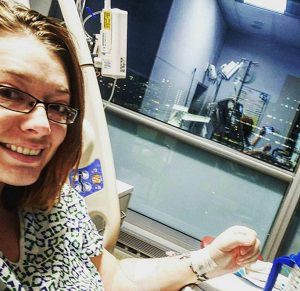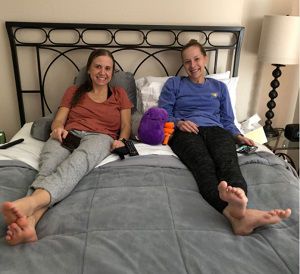CLEVELAND — April is National Donate Life Month. More than 100,000 people are waiting for life-saving organ transplants and another American is added to the waiting list every 10 minutes, according to Donate Life America.
What You Need To Know
- More than 100,000 people are waiting for organ transplants and another American is added to the waiting list every 10 minutes
- The Cleveland Clinic and other hospitals offer an organ donation swap program
- One woman’s desire to help others started a chain reaction involving seven people, including herself
One woman kicked off a chain of donations that changed seven people’s lives, including her own.
Holly Best is a person that when she decides she is going to do something, she follows through.
“Once I started, I want to finish it," she said.
She is determined, reliable, and Best admits she can be impulsive.
“You don’t need to know somebody to save somebody," she said.
Her love for helping others knows no bounds.
“Whatever is going to allow me to help the most people is what’s going to make me happy," said Best.

So when she stumbled upon a Facebook post in 2018 about the sister of a colleague’s friend who needed a kidney — she was all in without hesitation. She knew she was going to be the donor for the stranger.
“Kind of dive head first and not worry about things," she said.
After she started the process, doctors told her she needed to make some lifestyle changes in order to be eligible.
“It wasn’t really hard to hear, but it was hard to put into action," said Best.
It took her about a year, but she lost nearly 100 pounds and cut out drinking alcohol entirely.
“I framed it differently in this aspect like 'Oh someone may have to go on dialysis or worse if you don’t,’” she said.
Best said, to her surprise, cutting back on drinking was the hardest part.
“That was one of those things that was frustrating, because I’d never considered myself an alcoholic,” she said. “So after lots of denial and like self-arguments I was like, 'No, okay, you’re not going to let your drinking get in the way of somebody else’s like future, so just stop'."
By the time she was physically ready to give, the initial recipient that inspired and motivated her found another donor, but Best decided to donate anyway — to anyone.
“Four weeks of being a little sore versus saving somebody’s life is kind of, for me, it’s a no brainer,” she said.
That donation created a domino effect that allowed six people on the waiting list to receive kidneys at the Cleveland Clinic.
“You do it to help somebody else and then everything else is an added bonus,” Best said. “So, you know, I get to be healthier because I decided to help somebody else and that’s a win-win for me.”
Anne Lebold is part of the donation chain.
“I was lucky that it was only a few months for me as opposed to years and just being on dialysis kind of endlessly," said Lebold.

Her kidney disease came out of nowhere about a year ago.
“There was no history of any kidney disease in my family. No, nothing had shown up on the bloodwork years prior. It was really just out of the blue," she said.
Lebold’s three sisters were tested and none were matches, but one still decided to give in order to bump up Lebold’s spot on the waiting list — and that allowed them to be part of the swap.
Lebold sad Best gave her life back.
“Want to tell her thank you and let her know what she did for me because, you know, sometimes it was hard to remain positive and think that there would be an end in sight," said Lebold.
Best said she is now the best version of herself health-wise and is now focused on what she can give next.
“I told my nurse on the floor I was on 'Give me a year and I’ll just donate some liver too since that just grows back. It will be fine,' and she laughed at me," said Best.
How does a kidney swap work?
Some people have to wait years to be taken off the waiting list for life-saving organs. In light of that, the Cleveland Clinic and other hospital systems have kidney-swap programs to help speed up the process, which means if a person needs a kidney and knows someone willing to donate who isn’t a match, he or she may be eligible for a kidney swap.
The person’s willing donor gives to a stranger and a stranger gives to the other patient, swapping donors with someone else in need.
In this case, Lebold does not have Best’s kidney, but because of Best, she was able to get one in a swap that involved six people.


